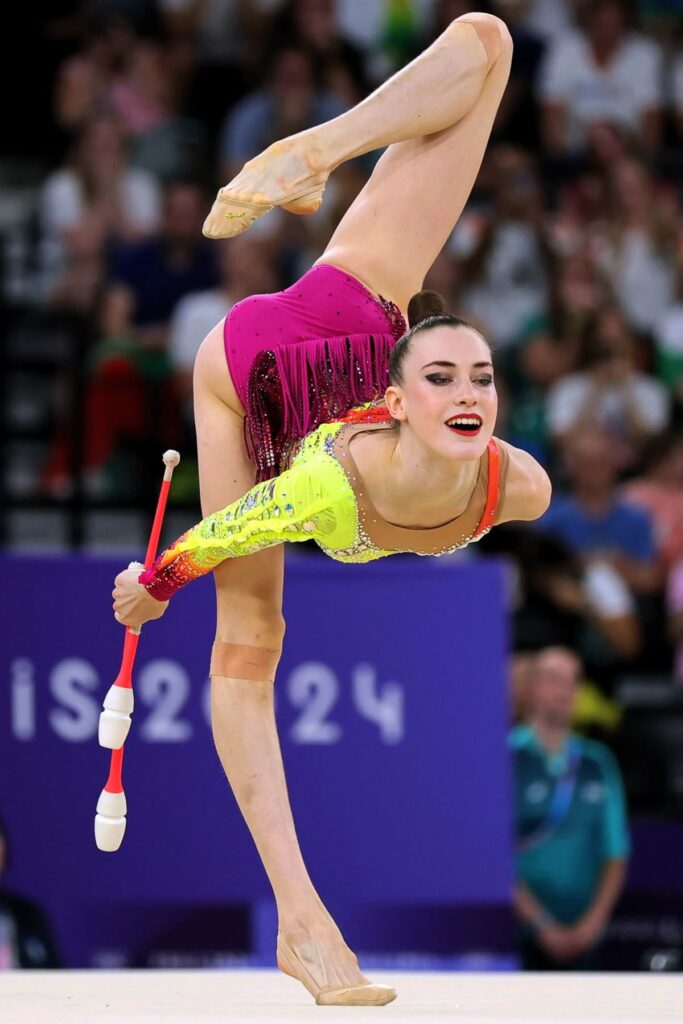Rhythmic gymnastics is one of the most captivating sports in the Olympic Games. Combining elements of ballet, dance, and acrobatics with apparatus manipulation, it showcases both artistry and athleticism in perfect harmony. The performances are dazzling, with athletes demonstrating incredible coordination, flexibility, and strength—all set to music that enhances the emotional and visual experience. In this blog post, we will explore the history, rules, apparatus, famous athletes, and the modern evolution of Olympic rhythmic gymnastics, giving readers a comprehensive understanding of why this sport stands as one of the most graceful and disciplined in the world.
1. What is Olympic Rhythmic Gymnastics?
Olympic rhythmic gymnastics is a sport where athletes perform choreographed routines using apparatuses such as ribbons, hoops, balls, clubs, and ropes. Unlike artistic gymnastics, which involves vaults, bars, and balance beams, rhythmic gymnastics focuses on continuous movement and expression. It blends technical skills with artistry, requiring immense precision, timing, and creativity.
The routines are performed either individually or in groups of five gymnasts. Each performance typically lasts around 90 seconds (for individuals) or 2 minutes and 30 seconds (for groups) and is accompanied by music that complements the choreography. The athletes must synchronize their movements perfectly with the rhythm and mood of the music while flawlessly executing throws, catches, pivots, and leaps.
2. The Origins and Olympic History of Rhythmic Gymnastics
Rhythmic gymnastics has its roots in early 20th-century Europe, inspired by rhythmic movement theories that emphasized the connection between physical motion and musical rhythm. The sport formally emerged in the Soviet Union during the 1940s and quickly gained international attention.
The first World Championships in Rhythmic Gymnastics were held in 1963 in Budapest, Hungary, marking a major milestone. It wasn’t long before the discipline found its way to the Olympic stage.
- 1984 Los Angeles Olympics: Rhythmic gymnastics made its Olympic debut as an individual event for women. Canada’s Lori Fung became the first-ever Olympic champion in rhythmic gymnastics.
- 1996 Atlanta Olympics: The group competition was introduced, adding another dynamic element to the sport.
- Since then, rhythmic gymnastics has been a permanent part of the Summer Olympic Games, celebrated for its elegance and technical brilliance.
Today, it remains an exclusively female discipline at the Olympics, though men’s rhythmic gymnastics is gaining popularity in other parts of the world, especially in Japan.
3. The Apparatus Used in Olympic Rhythmic Gymnastics
One of the most distinctive aspects of rhythmic gymnastics is the use of apparatus. Each apparatus brings a unique aesthetic and technical challenge, showcasing the gymnast’s control and creativity.
Ribbon
The ribbon is a long, flowing satin strip attached to a stick. Gymnasts create spirals, snakes, circles, and figure-eights while performing leaps and turns. The movement of the ribbon must be continuous and free of knots or tangles, making it one of the most visually striking apparatuses.
Hoop
The hoop is used for rolling, spinning, and tossing. Gymnasts perform intricate movements like jumping through or rotating the hoop while maintaining fluidity. The hoop’s circular motion symbolizes perfection and continuity, adding elegance to every performance.
Ball
The ball routine emphasizes fluid arm and body movements. Gymnasts roll, bounce, or toss the ball while maintaining graceful transitions and precise timing. The routine demands exceptional coordination between hand and body movements.
Clubs
The clubs are small batons handled in pairs. They require excellent hand-eye coordination for throws, catches, and rhythmic tapping. Routines with clubs are fast-paced, filled with intricate juggling and symmetrical movement patterns.
Rope
Although not currently featured in Olympic competitions, the rope was historically part of the event lineup. It involves skipping, swings, and throws that test speed, timing, and agility.
Each apparatus showcases a different aspect of the gymnast’s artistry and control, making every performance distinct and memorable.
4. Scoring and Judging in Olympic Rhythmic Gymnastics
Scoring in rhythmic gymnastics is a complex process that combines artistic, technical, and execution elements. Judges evaluate routines based on two main components:
- Difficulty (D Score): This includes the complexity of body movements, apparatus handling, and overall choreography. The more challenging the elements, the higher the potential score.
- Execution (E Score): This focuses on performance quality, precision, grace, and musical interpretation. Deductions are made for errors such as drops, imbalances, or synchronization issues.
The final score is the sum of these two components, with deductions applied for mistakes. In Olympic competitions, precision and elegance are equally valued, reflecting the sport’s balance between athleticism and art.
5. Training and Skills Required for Olympic-Level Rhythmic Gymnastics
To compete at the Olympic level, rhythmic gymnasts undergo years of rigorous training, often beginning at a very young age. A typical training schedule can exceed 30 hours per week, focusing on flexibility, strength, balance, and coordination.
Key training components include:
- Flexibility Exercises: Splits, backbends, and stretching routines to achieve the required range of motion.
- Ballet and Dance Classes: Essential for improving posture, grace, and rhythm.
- Apparatus Handling Drills: Mastery of throws, catches, and transitions with each apparatus.
- Endurance and Conditioning: Maintaining stamina for high-intensity performances.
Mental focus is equally vital. Athletes must maintain composure and confidence under immense pressure, especially during Olympic finals where one mistake can cost a medal.
6. Famous Olympic Rhythmic Gymnasts
Over the years, many rhythmic gymnasts have captivated audiences with their extraordinary performances.
- Evgenia Kanaeva (Russia): The only rhythmic gymnast to win two individual Olympic all-around gold medals (2008 and 2012). Her precision and elegance set new standards in the sport.
- Yana Kudryavtseva (Russia): Known for her technical perfection and emotional artistry, she earned multiple World Championship titles and a silver medal at the 2016 Olympics.
- Linoy Ashram (Israel): Made history in the Tokyo 2020 Olympics by becoming the first Israeli rhythmic gymnast to win an all-around gold medal, breaking Russia’s long-standing dominance.
- Alina Kabaeva (Russia): An Olympic medalist celebrated for her charisma and innovation in choreography.
These athletes embody the discipline, creativity, and grace that define Olympic rhythmic gymnastics.
7. Group Rhythmic Gymnastics: The Art of Synchronization
Group rhythmic gymnastics brings a thrilling dynamic to the Olympic stage. Teams of five gymnasts perform synchronized routines, often involving exchanges of apparatus mid-air. The precision required is astounding—each member must be in perfect harmony with the others.
Group routines feature:
- Collaborative Formations: Patterns that change fluidly throughout the performance.
- Complex Apparatus Exchanges: Apparatus are thrown and caught by teammates at long distances.
- Unified Choreography: Movements and rhythm are synchronized to music, emphasizing teamwork and artistry.
Group rhythmic gymnastics highlights the collective beauty of movement, turning athletic skill into visual poetry.
8. Evolution and Future of Olympic Rhythmic Gymnastics
Over the years, rhythmic gymnastics has evolved significantly. Modern routines incorporate a wider variety of music genres, from classical compositions to contemporary beats. The choreography has also become more expressive and athletic, with gymnasts pushing the boundaries of flexibility and control.
The sport continues to grow in popularity globally, with nations like Japan, Bulgaria, and Italy producing top-tier gymnasts who rival traditional powerhouses like Russia. The inclusion of new technologies in training—such as motion tracking and performance analytics—has also enhanced precision and performance quality.
Looking ahead, there’s growing discussion about introducing men’s rhythmic gymnastics to the Olympic Games, which could broaden the sport’s appeal and inclusivity.
9. Why Olympic Rhythmic Gymnastics Captivates the World
The enduring allure of rhythmic gymnastics lies in its unique fusion of sport and art. Every performance tells a story, expressing emotion through movement. The athletes’ grace, coupled with their physical prowess, captivates audiences across cultures and generations.
From the breathtaking toss of a ribbon to the flawless spin with a ball, rhythmic gymnastics transforms athletic competition into an elegant symphony of motion. It represents not just the pursuit of perfection, but also the beauty of human creativity and discipline.
Conclusion
Olympic rhythmic gymnastics is far more than a sport—it is a celebration of artistry, dedication, and elegance. Every movement is a reflection of years of training, passion, and precision. From its humble beginnings to its prestigious Olympic status, rhythmic gymnastics has become a universal symbol of grace and strength.

